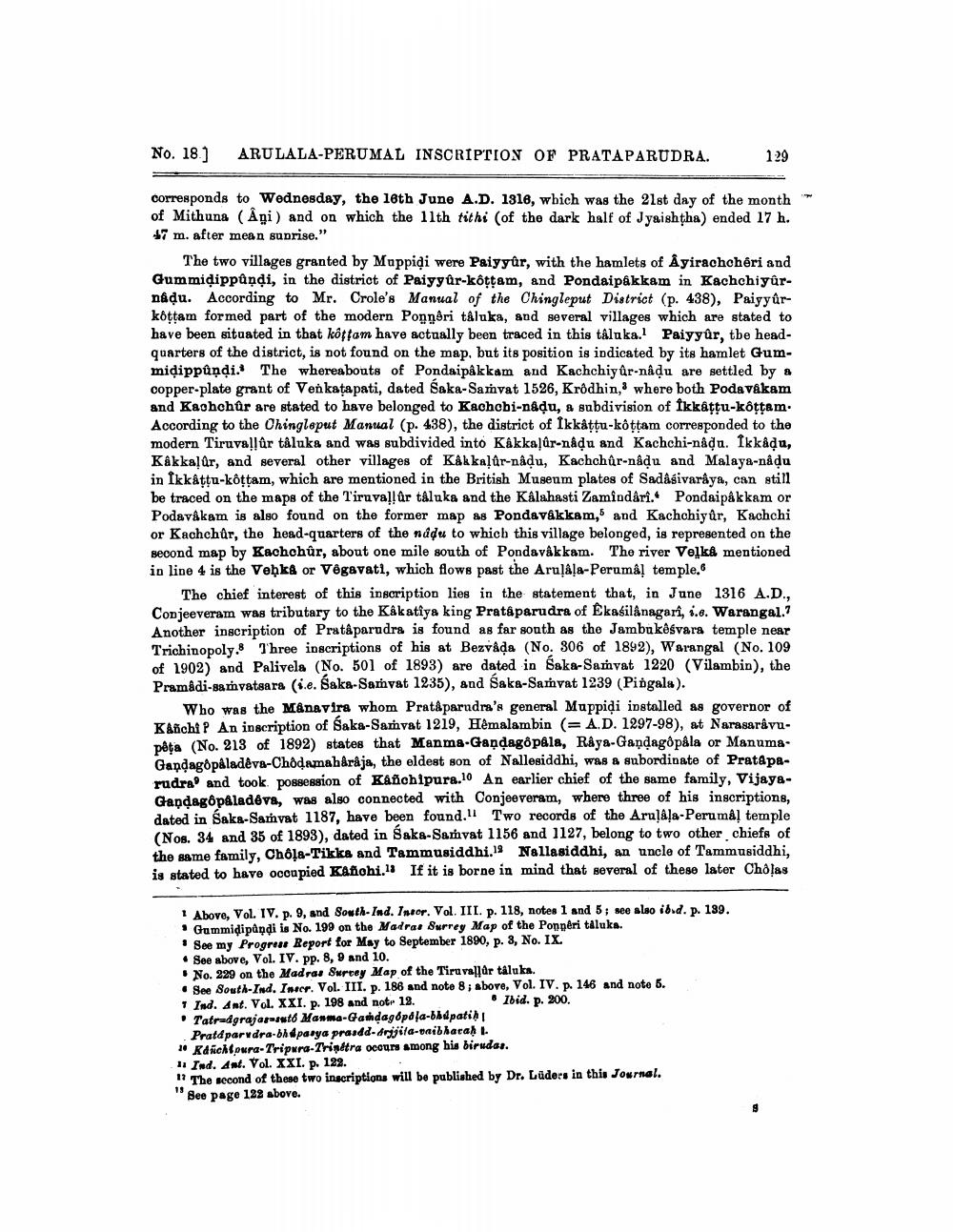________________
No. 18.)
ARULALA-PERUMAL INSCRIPTION OF PRATAPARUDRA.
129
corresponds to Wednesday, the 16th June A.D. 1316, which was the 21st day of the month *** of Mithuna (Agi) and on which the 11th tithi (of the dark half of J yaishtha) ended 17 h. 47 m. after mean suprise.
The two villages granted by Muppiời were Paiyyür, with the hamlets of Ayirachohêri and Gummidippundi, in the district of Paiyyûr-kóţtam, and Pondaipakkam in Kachchiyûrnádu. According to Mr. Crole's Manual of the Chingleput District (p. 438), Paiyyûrkottam formed part of the modern Popneri tåluka, and several villages which are stated to have been situated in that kottam have actually been traced in this taluka. Paiyyûr, tbe headquarters of the district, is not found on the map, but its position is indicated by its hamlet Gummidippûņdi. The whereabouts of Pondaipakkam and Kachchiyûr-nadu are settled by a copper-plate grant of Venkatapati, dated Saka-Samvat 1526, Krodhin, whore both Podavakam and Kachchur are stated to have belonged to Kachcbi-nadu, a subdivision of Ikkattu-kottam. According to the Chingleput Manual (p. 438), the district of Ikkattu-kottam corresponded to the modern Tiruvallûr tåluka and was subdivided into Kakkaļûr-nadu and Kachchi-nadu. Ikkadu, Kakkaļūr, and several other villages of Kakkaļür-nadu, Kachchûr-nådu and Malaya-nå du in Ikkattu-kottam, which are mentioned in the British Museum plates of Sadasivaraya, can still be traced on the mape of the Tiruval!ûr tåluka and the Kalahasti Zamindari. Pondaipakkam or Podavakam is also found on the former map as Pondavákkam, and Kachchiyûr, Kachchi or Kachchûr, the head-quarters of the nadu to which this village belonged, is represented on the second map by Kachchür, about one mile south of Pondavakkam. The river Velke mentioned in line 4 is the Vehka or Vegavati, which flows past the Aru!åļa-Perumal temple.
The chief interest of this inscription lies in the statement that, in June 1316 A.D., Conjeeveram was tributary to the Kakatiya king Pratáparudra of Ekasilanagari, 1.6. Warangal.? Another inscription of Pratâparudra is found as far south as the Jambukėsvara temple near Trichinopoly.8 Three inscriptions of his at Bezvada (No. 306 of 1892), Warangal (No. 109 of 1902) and Palivela (No. 501 of 1893) are dated in Baka-Samvat 1220 (Vilambin), the Pramadi-samvatsara (i.e. Saka-Samyat 1235), and Saks-Samvat 1239 (Pingala).
Who was the M&navira whom Prataparudra's general Muppidi installed as governor of KAñchi P An inscription of Saka-Samvat 1219, Hemalambin (= A.D. 1297-98), at Narasarávupêta (No. 213 of 1892) states that Manma-Gandagôpåla, Råya-Gandagópåla or Manuma. Gandagôpåladeva-Chodamah&råja, the eldest son of Nallesiddhi, was & subordinate of Prat&parudra and took possession of Kanchipura.10 An earlier chief of the same family, VijayaGandagöpfladeva, was also connected with Conjeeveram, where three of his inscriptions, dated in Saka-Samyat 1187, have been found. Two records of the Aru!!a-Perumal temple (Nos. 34 and 35 of 1893), dated in Saka-Samvat 1156 and 1127, belong to two other chiefs of the same family, Chla-Tikka and Tammusiddhi. Nallasiddhi, an uncle of Tammusiddhi. is stated to have occupied Kanohi. If it is borne in mind that several of these later Cholas
1 Above, Vol. IV. p. 9, and South-Ind. Tror. Vol. III. p. 118, notes 1 and 5: see also ibid. p. 189. • Gummidipandi is No. 199 on the Madrat Surrey Map of the Popperi taluks. • See my Progress Report for May to September 1890, p. 3, No. IX. • See above, Vol. IV. pp. 8, 9 and 10.
No. 229 on the Madras Survey Map of the Tiruvallur taluks. • See South-Ind. Ineer. Vol. III. p. 186 and note 8; above, Vol. IV. p. 146 and note 6. 1 Ind. Ant. Vol. XXI. p. 198 and note 13.
Ibid. p. 200. Tatradgrajarautó Manma-Gandagópola-badpatibi
Pratá parvdra-bhd pasya prasdd-drijila-vaibharah I. 2. Kdjich pura-Tripura-Trinitra ocours among his birudas. 1. Ind. Ant. Vol. XXI. p. 122. 11 The second of these two inscriptions will be published by Dr. Lüders in this Journal. "See page 122 above.




